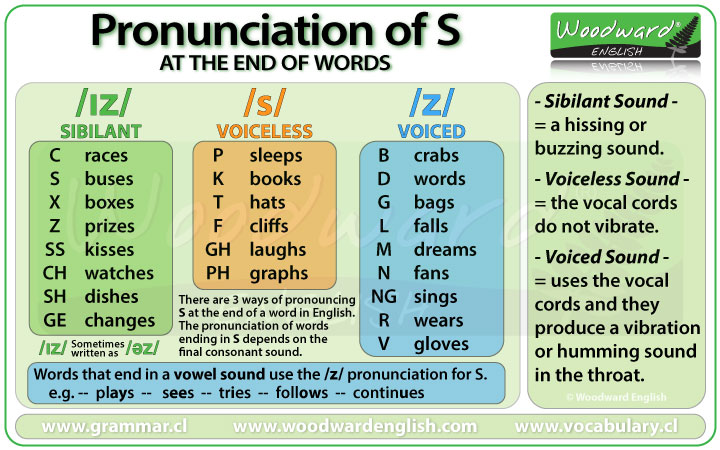Plural Nouns and Verbs in Third Person
The pronunciation of S at the end of plural nouns, verbs in third person and as a part of the possessive case sometimes causes problems for non-native speakers because it can be pronounced in three different ways: / ɪz /, / s / or / z /.
(Note: whenever you see letters or symbols between two slash marks (/ /), it refers to the pronunciation of that letter or sound)
The pronunciation depends on the last sound of the verb or noun which is usually a consonant. Before we learn the difference ways to pronounce the final S, we must first know what voiced and voiceless consonants are as well as sibilant sounds:
Voiced Consonants vs. Voiceless Consonants
A voiced consonant (or sound) means that it uses the vocal cords and they produce a vibration or humming sound in the throat when they are said. Put your finger on your throat and then pronounce the letter L. You will notice a slight vibration in your neck / throat. That is because it is a voiced sound.
A voiceless sound (sometimes called unvoiced sound) is when there is no vibration in your throat and the sound comes from the mouth area. Pronounce the letter P. You will notice how it comes from your mouth (in fact near your lips at the front of your mouth). The P sound doesn't come from your throat.
Try this with the other letters and you will "feel" the difference between a voiced and a voiceless consonant (or sound).
Sibilant Sounds
Another sound which is relevant to this is the sibilant sound which is produced by forcing air out toward your teeth. Is is characterized by a hissing sound (sssss), a buzzing sound (zzzzz) or the sound teachers make when they want you to be quiet (shhhh!).
- Z like the sound a bee makes... zzzzzz
- S like the sound a snake makes... sssssss
- SH like the sound a teacher makes when they want you to be quiet... shhhhh
Now we know the difference between voiced, voiceless and sibilant sounds we can look at the following rules for the correct pronunciation of S at the end of words in English:
The pronunciation of the S at the end of words in English
The pronunciation of the final S in plural words and verbs in the third person depend on the final consonant sound before that S.
The ending is pronounced /s/ after a voiceless sound, it is pronounced /z/ after a voiced sound and is pronounced /ɪz / or /əz/ after a sibilant sound:
- Voiceless: helps /ps/ -- sits /ts/ -- looks /ks/
- Voiced: crabs /bz/ -- words /dz/ -- gloves /vz/,
- Sibilant: buses /sɪz / or /səz /, bridges /dʒɪz / or /dʒəz /, wishes /shɪz / or /shəz /
1. The /ɪz/ sound (or /əz/ sound)
Sometimes this sound is written as /əz/ and uses the symbol "schwa" or "upside down e" before the z. For ease we will write this sound as /ɪz/ or /iz/
If the last consonant sound of the word is a sibilant sound (a hissing or buzzing sound), the final S is pronounced as /ɪz/. This /ɪz/ sound is pronounced like an extra syllable. (e.g. the word buses has two syllables)
If the sound has a J sound (/dʒ/ like the letter J at the beginning of the word jacket or /ʒ/ like the S in pleasure), then the final S is also pronounced as /ɪz/.
Examples of words ending in the /ɪz/ sound:
- C: races (sounds like "race-iz")
- S: pauses, nurses, buses, rises
- X: fixes, boxes, hoaxes
- Z: amazes, freezes, prizes, quizzes
- SS: kisses, misses, passes, bosses
- CH: churches, sandwiches, witches, teaches
- SH: dishes, wishes, pushes, crashes
- GE: garages, changes, ages, judges
Remember: after verbs ending in -sh, -ch, -ss and -x, we add the -es to the end of the verb (in third person) and the pronunciation is /iz/ as an extra syllable.
2. The /s/ sound
If the last consonant of the word is voiceless, then the S is pronounced as /s/. Be careful not to create an extra syllable.
NOTE: The consonants c, s, sh, ch and x are voiceless though they use the sibilants ending seen above.
Examples of words ending in the /s/ sound:
- P: cups stops, sleeps
- T: hats, students, hits, writes
- K: cooks, books, drinks, walks
- F: cliffs, sniffs, beliefs, laughs, graphs (the -gh and -ph here are pronounced like a F)
- TH: myths, tablecloths, months (voiceless th)
3. The /z/ sound
If the last letter of the words ends in a voiced consonant (or sound), then the S is pronounced like a Z /z/(without creating another syllable). This Z sound is similar to the sound a bee makes zzzz.
We also use this ending when the word ends in a vowel sound (e.g. bees, flies etc.)
Examples of words ending in the /z/ sound:
- B: crabs, rubs
- D: cards, words, rides, ends
- G: rugs, bags, begs
- L: deals calls, falls, hills
- M: plums, dreams
- N: fans, drains, runs, pens
- NG: kings, belongs, sings
- R: wears, cures
- V: gloves, wives, shelves, drives
- Y: plays, boys, says,
- THE: clothes, bathes, breathes
- VOWEL SOUNDS: sees, fleas








0 Comments